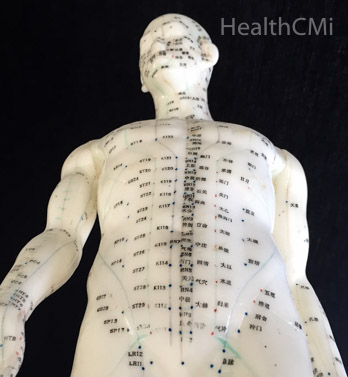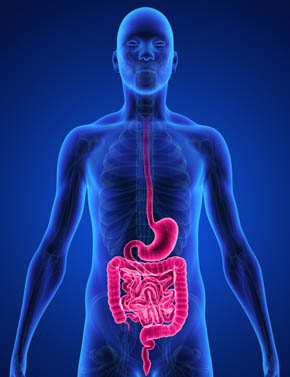Acupuncture reduces intestinal inflammation in patients with Crohn’s disease, reverses tissue damage, and improves the quality of life. Until now, how acupuncture achieves these results has gone unanswered.  Researchers sought to solve this mystery and came up with concrete answers. With the help of immunohistochemistry, researchers discovered how acupuncture works for these patients.
Researchers sought to solve this mystery and came up with concrete answers. With the help of immunohistochemistry, researchers discovered how acupuncture works for these patients.
Crohn’s disease is an inflammatory bowel disease (IBD) characterized by abdominal pain, diarrhea, intestinal obstructions, abdominal masses, fatigue, nausea, mouth ulcers, and many other disruptions of the gastrointestinal system. Demographically, it disproportionately affects Scandinavians and Ashkenazim Jewish people. Crohn’s disease often affects the colon, anus, and terminal ileum (the distal aspect of the small intestine connecting to the cecum). Deep intestinal ulcerations with a patchy distribution throughout the gastrointestinal system help to distinguish Crohn’s disease from ulcerative colitis. Crohn’s disease has a serpiginous distribution of inflammation whereas ulcerative colitis has a contiguous distribution of inflammation.
Acupuncture and moxibustion have been shown to improve CDAI (Crohn’s Disease Activity Index) scores in modern research. CDAI scores are a method of measuring clinical responses to medicine and medical procedures by quantifying responses and remissions of Crohn’s disease. The researchers note that studies show that acupuncture improves CDAI scores, quality of life, increases hemoglobin levels, and reduces CRP levels for Crohn’s disease patients.
CRP (C-reactive protein) is determined by a blood test and quantifies inflammation levels. High levels indicate inflammation, often due to infections and chronic disease. The research demonstrates that acupuncture significantly lowers CRP levels for Crohn’s disease patients. With the help of an Olympus flourescent microscope, the researchers learned how acupuncture and moxibustion induce a powerful anti-inflammatory response in human patients with Crohn’s disease.
A confirmation of acupuncture and moxibustion’s benefits became apparent in a before and after intestinal biopsy comparison. Prior to acupuncture and moxibustion, patients had a significantly elevated level of giant, multinucleated cells in granulomas. Inflammatory and necrotic cells infiltrated the center of the granulomas. The mucosa epithelium was either damaged or completely absent. Lymphocytes infiltrated the lamina propria and intestinal glands were damaged. The glands contained necrotic, inflammatory, and multinucleated giant cells. After acupuncture and moxibustion, significant improvements were documented. The researchers note that the “intestinal mucosal epithelium was intact, the intestinal glands were reorganized, and less inflammatory cells infiltrated.”
The researchers carefully mapped the biological mechanisms regulated by acupuncture and moxibustion that achieved successful clinical results. What they discovered was that acupuncture and moxibustion induce a homeostatic response on the cellular level. Acupuncture and moxibustion relieved intestinal inflammation by regulating the ratio of inflammatory response cells. Proinflammatory Th17 cells and anti-inflammatory Treg cells were restored to normal levels and intestinal inflammation subsequently reduced. The researchers note this “study shows that moxibustion and acupuncture can reduce the number of Th17 cells and downregulate the expression of Th17-related molecules IL-17 and RORγt and increase the number of Treg cells and upregulate the expression of Treg transcription factor FOXP3 in the intestinal mucosa of CD (Chron’s disease) patients.” They add, “The present study showed that moxibustion and acupuncture can regulate and restore the balance between Th17 and Treg cells in intestinal mucosa of patients with CD."
The randomized study compared the results of acupuncture and moxibustion against a sham-placebo control group to ensure the validity of the results. Imaging, endoscopy, and histopathological exams confirmed the results. The research team shared the exact acupuncture and moxibustion procedures used to achieve clinical success. First, let’s look at the cellular changes induced by acupuncture and moxibustion. Next, we go over the exact acupuncture and moxibustion treatment protocol that helped the patients.
Citing Hovhannisyan et al., the researchers note, “An imbalance between Th17 and Treg cells constituted a key step in the disruption of intestinal homeostasis and is one of the major contributors to the development and progression of CD (Crohn’s disease).” TH17 (T helper 17) cells exert proinflammatory responses while Tregs (regulatory T cells, suppressor T cells) exert anti-inflammatory responses, especially in the case of auto-immune disorders. Crohn’s disease, which is often understood as an autoimmune disease, is characterized by unregulated proinflammatory responses. The study documents that acupuncture and moxibustion regulate the cells thereby balancing proinflammatory and anti-inflammatory responses. 
The RORγt protein promotes differentiation of cells into proinflammatory Th17 cells. TH17 cells secrete proinflammatory cytokines including IL-17, which creates powerful proinflammatory responses. This causes neutrophils to migrate towards infections as part of the inflammatory cascade. Acupuncture and moxibustion downregulate IL17, RORγt, and TH17 cells.
The researchers add that “Th17 cells are the major contributor to inflammation in CD (Crohn’s disease)” and IL-17 is positively correlated with Crohn’s disease severity. This study demonstrates that acupuncture and moxibustion “reduced the number of TH17 cells and inhibited the expression of TH17-related molecules IL-17 and RORγt in the intestinal mucosa. It also increased the number of Treg cells and the expression of Treg-specific transcription factor FOXP3, thus restoring the ratio of the two cell types."
The researchers note that “a reduction in the number or function of Treg cells might be a major cause of the pathogenesis of Crohn’s disease. Tregs can suppress intestinal mucosal inflammation induced by innate or acquired immunity. FOXP3 and IL-2 promote the differentiation of Treg cells. Reduced numbers of Treg cells and deficiency in their function can cause damage in the intestinal mucosa, resulting in CD (Crohn’s disease).” Tregs can inhibit the proliferation of Th cells and subsequent production of inflammatory factors although they may differentiate into Th17 cells in other instances. Research demonstrates that reduced Tregs and FOXP3 in the bloodstream are correlated with Crohn’s disease. Moreover, the ratio of Treg to Th17 cells both in the intestinal mucosa and peripheral bloodstream is reduced in patients with Crohn’s disease. The researchers note that “restoring the balance between these cells is essential for the treatment of intestinal inflammation in CD.” Acupuncture and moxibustion restored the balance between these cells and testing also revealed significant positive patient clinical improvements.
Treatment
Acupuncture was administered at the following acupoints:
- Zusanli (ST36)
- Shangjuxu (ST37)
- Sanyinjiao (SP6)
- Taixi (KI3)
- Gongsun (SP4)
- Taichong (LR3)
The acupuncture needles were 0.30 mm x 25 - 40 mm. Needle depth was between 20 - 30 mm and manual acupuncture techniques were used to elicit the de qi response. Needle retention time was 30 minutes. Both acupuncture and moxibustion were administered three times per week for 12 weeks for a grand total of 36 acupuncture combined with moxibustion sessions.
Moxibustion was administered at the following acupoints:
- Tianshu (ST25)
- Qihai (CV6)
- Zhongwan (CV12)
Moxa cones of a 16 mm height and a 17 mm diameter were placed atop of an herb cake. Two moxa cones were burned on the herbal cakes place atop of each acupoint. The herbal cakes formed from a paste made from a fine herbal powder mixed with maltose and water. The paste was used to form the 28 mm diameter x 5 mm height cakes made primarily of the following herbs:
- Coptis chinensis (Huang Lian)
- Radix Aconiti Lateralis (Fu Zi, aconite)
- Cortex Cinnamomi (Rou Gui, cinnamon bark)
- Radix Aucklandiae (Mu Xiang)
- Flos carthami (Hong Hua, saffron)
- Salvia miltiorrhiza (Dan Shen)
- Angelica sinensis (Dang Gui)
Patients with Crohn’s disease are often treated with corticosteroids, immunosuppressants, aminosalicylates, and anti-TNF-alpha medications. This research demonstrates that acupuncture combined with herb-partitioned moxibustion is another helpful treatment regime for patients with Crohn’s disease. In addition, the research has measured how acupuncture and moxibustion affect cellular responses and secretions to reduce intestinal inflammation for patients with Crohn’s disease. The Healthcare Medicine Institute offers an acupuncture continuing education course on the treatment of colitis, Crohn’s disease, and chronic appendicitis. This includes acupuncture and herbal medicine protocols. The online course is accepted by the NCCAOM for PDA credit and in the USA and Canada for acupuncture CEU credit.
References:
Zhao, Chen, Chunhui Bao, Jing Li, Yifang Zhu, Siyao Wang, Ling Yang, Yin Shi et al. "Moxibustion and Acupuncture Ameliorate Crohn’s Disease by Regulating the Balance between Th17 and Treg Cells in the Intestinal Mucosa." Evidence-Based Complementary and Alternative Medicine (2015).
Bao, Chun-Hui, Ji-Meng Zhao, Hui-Rong Liu, Yuan Lu, Yi-Fang Zhu, Yin Shi, Zhi-Jun Weng et al. "Randomized controlled trial: Moxibustion and acupuncture for the treatment of Crohn’s disease." World journal of gastroenterology: WJG 20, no. 31 (2014): 11000.
Z. Hovhannisyan, J. Treatman, D. R. Littman, and L. Mayer, “Characterization of interleukin-17-producing regulatory T cells in inflamed intestinal mucosa from patients with inflammatory bowel diseases,” Gastroenterology, vol. 140, no. 3, pp. 957–965, 2011.


